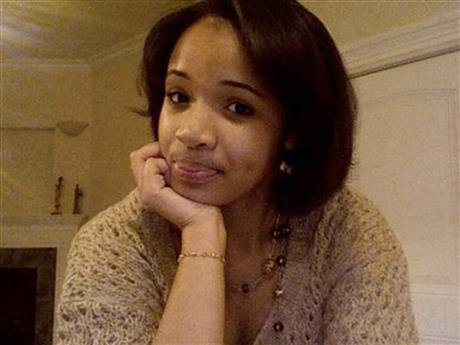CHICAGO (AP) — The low point so far in Chicago’s closely watched battle with street gangs may have been the day that Michelle Obama came home for the funeral of a teenage honor student.

A year ago, the city’s bloodiest January in more than a decade had just ended. On Feb. 9, 2013, the first lady stood in a church mourning 15-year-old Hadiya Pendleton, who had been shot dead in a gang dispute she had nothing to do with. It happened just a mile from the Obamas’ Chicago house.
Since then, the number of homicides and other violent crimes that turned Chicago into a national symbol of gun violence have fallen sharply.
The city led the nation in homicides in 2012 with more than 500. It ended 2013 with 415 homicides — the lowest total in nearly a half-century but still far more than any other U.S city, including much larger Los Angeles and New York.
The overall crime rate fell last year to a level not seen since 1972, and the number of shooting incidents involving victims 16 and younger dropped 40 percent in 12 months, city officials say.
Some wonder if the decline is a result of spending nearly $100 million on police overtime. But city officials insist the numbers are evidence that changing police tactics and creating and expanding after-school jobs and mentoring programs for young people are paying off.
Nobody believes the problem has been solved. Yet Hadiya Pendleton’s great uncle, Nathaniel Pendleton, feels more hopeful.
It’s a long way from people feeling like they can sit out on their porches, he said. But it is getting a little better.
On the day of the first lady’s visit, Chicago’s violence problem was making international headlines, posing an enormous challenge to Mayor Rahm Emanuel, a former White House chief of staff. The mayor stressed that the problem mostly affected gang-plagued neighborhoods on the city’s South and West sides and that police were doing everything possible to contain it.
In response, authorities launched a multi-pronged effort that started with a gang audit, a massive pooling of information about specific gangs and their members.
We identified gang turfs, membership, who’s in conflict with who, put it into a database and put that into the hands of beat officers, Police Superintendent Garry McCarthy said in an interview with The Associated Press.
With that information, he said, officers could focus on particular gangs and members and move quickly into areas where gangs might attack each other.
McCarthy, formerly the police chief in Newark and a high-ranking commander in New York, said officers have also alerted gangs that if one of their members kills somebody, police will go after everyone in the gang for any infraction — from welfare fraud to failure to pay taxes.
McCarthy said he’s expanding on a system his predecessor, Jody Weis, launched when Weis met with gang members to deliver the same message — a move that some alderman criticized as coddling criminals.
Today, the department also provides gang members with information about social services and even sets up meetings between them and the parents of murder victims to give them a sense of what they are doing to the community.
McCarthy says it’s the largest program of its kind in the nation and will be expanded this year.
So, too, will the department’s so-called heat lists of people deemed likely to kill or be killed. Officers gathered statistics showing that associates of murder victims are 100 to 500 times more likely to end up on either side of a slaying. Last summer, they hand-delivered letters to 25 people warning them of those dangers and asking what police could do to help.
Since then, some have been arrested for low-level offenses, but none has been a victim or an offender of gun violence, McCarthy said.
The efforts come at a time when some state lawmakers have made it known that they want more than tougher penalties for criminals — a message they sent when they halted a measure supported by the mayor that would have imposed stiffer sentences on ex-cons and known gang members caught with illegal guns. Critics feared it would disproportionately target young black and Latino men before they could be rehabilitated.
Emanuel pushed for revamping state law last spring but was rebuffed by members of the Black Caucus, who insisted that the city take a broader approach to law enforcement than just locking up youths. The Rev. Jesse Jackson appeared at the Illinois Capitol to support their efforts.
Jackson said the drop in violence should be applauded, but the daily count of shootings and killings is just one dimension of the violent culture.
The violence of economic disparity and poverty has not moved measurably, Jackson told The Associated Press this week.
Since then, city officials have said they will try again to pass the stiffer-sentence legislation, but they also have called more attention to programs that line up jobs and mentoring opportunities and behavioral therapy for at-risk youths.
Statistics suggest the city’s summer-jobs program has helped protect the 20,000 kids who participated last year.
Out of the 20,000, there were no shooting incidents with those kids, said Evelyn Diaz, commissioner of Chicago’s Department of Family and Support Services.
One alderman, Howard Brookins, Jr., said publicly what several officers have worried about quietly: If the financially strapped city ever stops paying for overtime to flood high-crime areas with uniformed officers, the crime will spike again.
Maybe one more year we can do it, but I don’t know how that can be sustainable long-term, Brookins said.
Emanuel said he does not expect the department to spend nearly as much on police overtime this year as authorities shift their focus to a core group of about 1,000 offenders believed to be responsible for much of the crime.
Last year we saturated the zones, and now we are going to be saturating the individuals creating the problem, the mayor said.
The city will also have nearly 800 new officers on the streets who recently graduated from the police academy, he added.
A few blocks from where Hadiya was shot, 21-year-old Austin Walker said the neighborhood does seem safer.
There’s not a lot of violence around here since it happened, Walker said. There’s more police around, and more people are doing more, too to ensure students get home safely.
___
Associated Press Writer Sophia Tareen contributed to this report.





